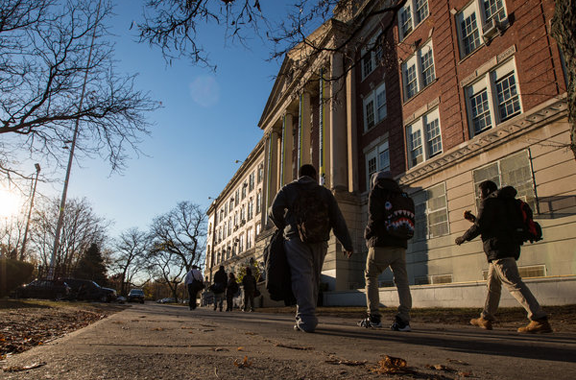Photograph; The Franklin K. Lane Educational Campus in Brooklyn. Mayor Michael R. Bloomberg has been an advocate for the letter grade system, which has become one of the country’s most complex.
May the era of school grades begin its descent. May all those affected in New York, children, parents, educators, and administrators finally rest in peace.
Bloomberg Issues Final Letter Grades for New York Schools
Nothing came to epitomize the era of education reform under Mayor Michael R. Bloomberg like the A-through-F letter grades he gave New York’s schools.
Educators obsessed over them, hoping their schools would avoid being marked for closing. Principals pored over them, knowing that fluctuations in test scores could determine end-of-the-year bonuses. Parents in some neighborhoods proudly ignored them, arguing that a single letter could not sum up the quality of a school.
On Wednesday, the Bloomberg administration released its last batch of grades for more than 1,600 public schools. Across the city, 63 percent of schools received A’s and B’s, and there were signs that schools were better preparing students for college.
But the announcement came with a sense of acquiescence, as Mr. Bloomberg, who staked his legacy on taking control of education in the city, prepares to hand over the school system to Mayor-elect Bill de Blasio, an ardent critic of the mayor’s policies who has pledged to do away with the letter grades.
Mr. Bloomberg on Wednesday emphasized the system’s value for parents. “Getting it down to something that they can use, I think, is not making it too simplistic but, quite the contrary, I think it’s making it useful,” he said at an unrelated news conference, according to WNYC.
Mr. de Blasio has denounced the letter grades, which were introduced in 2007, as blunt instruments that do not convey a nuanced portrait of a school’s strengths and weaknesses.
Lis Smith, a spokeswoman for Mr. de Blasio, said on Wednesday that letter grades offered “little real insight to parents and are not a reliable indicator of how schools are actually performing.”
Mr. de Blasio has said he would continue to make available the detailed report cards that accompany the letter grades given to schools each year, though he would convene a panel of parents and educators to determine whether they should continue in the long run.
Across the country, 14 states give letter grades to schools, according to the Foundation for Excellence in Education, a group founded by Jeb Bush. Advocates of the practice argue that letter grades — a glaring F, for instance — help nudge schools toward better performance in a way that vague pronouncements of proficiency do not. They also say the ratings help identify schools that are making gains with struggling students, so their strategies can be shared. Some states and cities have experimented with alternatives to letter grades, including star ratings and Roman numerals. Michigan uses a color-coded system, rating schools as green, lime, yellow, orange or red.
New York State issues report cards to schools that include information on test scores and demographics, but do not offer overall judgments, aside from noting compliance with federal standards.
Mr. Bloomberg took the idea of grading schools to a new level, inviting data experts to design a model that did not penalize schools with high populations of disadvantaged students, in the hope that they could be judged more fairly against affluent schools.
The result was one of the most complex grading systems in the country, which compared schools serving similar student populations and focused on how much progress students made each year on exams — not just their overall performance.
Almost from the outset, Mr. Bloomberg’s report cards came under attack. Teachers faulted the mayor for emphasizing grades in deciding which schools to close, and for maligning struggling schools. Parents denounced his emphasis on test scores. (In the report cards released on Wednesday, which covered the 2012-13 school year, test scores made up 85 percent of grades for elementary and middle schools; the remaining portion was based on surveys of students, parents and teachers, and attendance rates.)
Mr. Bloomberg was undeterred. The city brought letter grades to restaurants, based on sanitation inspections. Some city officials even began using the A-through-F system to informally rate their subordinates.
But the report card system encountered hiccups, including in 2009, when 97 percent of schools were awarded A’s and B’s. The city responded by refining its formula each year, but the criticism did not abate. “Bloomberg and his team tried to build a system that was as robust as they were able to design, but in schools, unlike in financial markets, there is a lot of sentiment,” said Frederick M. Hess, an education scholar at the American Enterprise Institute, adding, “No matter how sophisticated or smart the systems are, they’re ultimately vulnerable to those concerns.”
In the early years, Mr. Bloomberg, flanked by top education officials, made a point of trumpeting letter grades at news conferences, warning of harsh consequences for failing schools.
But the public rollout became more low-key in recent years. This time, the mayor was not present when grades were released to the news media; nor was the schools chancellor, Dennis M. Walcott.
In presenting the results, Shael Polakow-Suransky, the department’s second-in-command, said the city had made progress in trying to make the report cards more nuanced during Mr. Bloomberg’s tenure. He said the city had begun experimenting in using alternative measures, such as class projects and student grades, instead of standardized exams.
In addition, the city has turned its focus to how well schools prepare students for college. This year, the city judged high schools on whether their graduates were still enrolled in college after three semesters — a point at which many students drop out, education officials said.
The latest report cards incorporated student scores on reading and math exams aligned with more rigorous standards known as the Common Core, which were introduced in grades three through eight in the spring. Many schools reported dismal results on the tests, prompting the city to adjust its grading formula for schools to account for the difficulty of the exams.
The Education Department said it would not begin phasing out schools based on the results from the report cards this year. Mr. de Blasio has said he would move away from Mr. Bloomberg’s practice of closing schools.
The reaction to Mr. Bloomberg’s final report cards was mixed. Some educators welcomed what they saw as the end of an era, while others said they thought it was important that the city not lose its focus on measuring results.
Elizabeth Phillips, principal of Public School 321, an elementary school in Park Slope, Brooklyn, said the school had always earned a grade of A or B. But she said the grades were “completely meaningless.”
“They fluctuate dramatically, from year to year, even when there are no significant changes in the instruction, or the leadership or the teaching staff,” said Ms. Phillips, who has led the school for 15 years.
At Public School 3, an elementary school in the West Village, parents were optimistic about how Mr. de Blasio could change the grading system. The school received an A this year, after earning C’s the two years prior.
“It does not paint the entire picture of any school,” Dana Abraham, a co-president of the school’s PTA, said.
Al Baker contributed reporting.












Leave A Comment